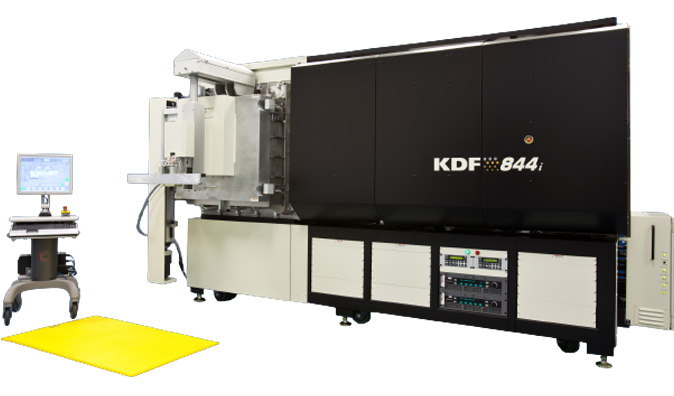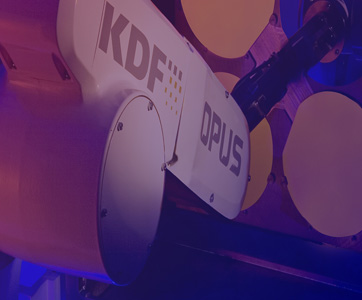Today’s consumers are accustomed to a certain level of imperfection in electronic devices.
An LED flashlight may fail. A laptop may no longer boot up the way it did just yesterday. But while these everyday equipment deficiencies may be accepted as part of modern living, the stakes are much higher when it comes to medical devices.
“Our customers in the implantable medical device industry demand the highest level of quality and precision,” said Todd Plaisted, director of marketing, KDF. “Equipment failure to perform is simply not an option for companies that produce pacemakers and defibrillators.”

Like all KDF sputtering tools, 844i Series systems are designed to meet demanding processing
requirements and feature an intuitive interface to monitor parameters.
[spacer height="30px"]
Founded in 1986, KDF is a leading supplier of physical vapor deposition (PVD) batch inline sputtering tools. These vacuum coating systems are used in the production of mainstream silicon, emerging materials, fl at panel displays, optical communications and medical devices. From headquarters in Rockleigh, New Jersey, KDF serves a global customer base and supports more than 3,300 systems in the field.
“More than half of the semiconductor fabs in the world use a KDF system in wafer processing,” Plaisted said. “And we extend the same quality the medical device market demands to all industries we serve.”
Virtually always located in a cleanroom environment, sputtering tools precisely deposit thin films of various materials, metals and/or dielectrics onto a substrate.
Next, the wafers typically enter etching or patterning equipment. Depending on the application, the substrate can return to the sputtering system several times during the manufacturing process to add different layers.
“Recipe management is critical throughout this process,” said Marc Fregeau, software development manager, KDF. “We develop all the programming for our customers – and update the software for them as their processes change.”
As more companies embrace contract fabrication, recipe control and monitoring has become increasingly important. In this emerging business model, a manufacturer provides fabrication services for a wide range of customers – each requiring different processes.
In 2010, KDF adopted a Rockwell Automation® control and information platform for their equipment featuring an Allen-Bradley® CompactLogix™ controller and an RSView®32 HMI solution.
“The initial control solution met our requirements,” Fregeau explained. “But as our customers’ process requirements became more demanding, we needed a more robust visualization solution that could grow with us.”
To enhance system performance, the company recently migrated to a FactoryTalk® View Site Edition (SE) HMI platform. In addition, the company opted for a CompactLogix 5370 controller (L36ERM), which features faster processor speeds and supports up to 16 axes of integrated motion over an EtherNet/IP™ network.
“Moving from the 32-bit HMI to the 64-bit FactoryTalk View solution was key,” Fregeau explained. “It provides a framework for an easy-to-use recipe management system – and the capacity to meet the demand for real-time information in a complex process environment.”
KDF systems are designed to monitor all process parameters including power supply voltages, sputter gas pressures/ratios, residual gas analyzer (RGA) background species vacuum integrity checks, substrate temperatures and more. The FactoryTalk View application helps enable real-time operator monitoring of those parameters through intuitive displays – and provides an audit trail of operator and alarm information in a centralized log database for absolute process validation.
“If there’s a process anomaly, the data logging helps determine the root cause,” Fregeau said. “The system also allows us to actively take ‘snapshots’ of the process in real time for reporting purposes.”
As an option, KDF customers can add FactoryTalk Historian to their system. FactoryTalk Historian features built-in connectivity to FactoryTalk View and provides robust, high-speed data collection and analysis capabilities.
For efficient system development, KDF applies the same Rockwell Automation control and visualization platform across its complete machine portfolio.
“Our sputtering tools share many components – as well as the control system,” Plaisted said. “A shared platform allows us to develop versatile equipment very cost-effectively.”
Looking toward the future, KDF is positioned to respond to fluctuating customer requirements – and an unpredictable marketplace.
“We are constantly changing,” Plaisted said. “And the Rockwell Automation control environment allows us to configure our tools and make changes as we need them.”


